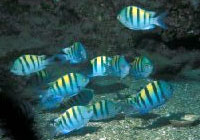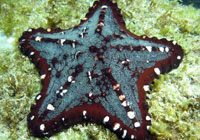We slide the kayak into the water, careful to shuffle our feet in the sand. The shuffling warns otherwise docile sting rays, who take offense only to being stepped on their back. Jorge laughs, shakes his head in disbelief, as he tells us of the ladies who ignore the signs about sting rays and shuffling, and proceed with their high-kicking water aerobic workouts.
The sand is less fine than, say, that of a California beach. It is largely accumulated from the far end of the digestive tracts of reef-eating fish. Underwater, you can hear the nibbling, biting, grinding of the reef by perhaps hundreds of fish – it sounds electric as if a downed power line were sparking on a street.
See what we see on our Baja Mexico reef fish identification page.
We kayak away from the beach, south, around the reef and rock that borders a signature hole on the golf course. Past the lagoon, where the occasional fishing boat motors by, we make our way towards small sandy coves surrounded by sheer cliffs of sixty or more feet.
 The water is impossibly clear and glassy this morning, schools of fish swim by inches below the surface – small Panamic Sergeant Majors with their distinctive black and yellow vertical stripes. Farther down in the waters, we see King Angelfish, Graybar Grunt, the occasional sting ray on the sandy bottom far below.
The water is impossibly clear and glassy this morning, schools of fish swim by inches below the surface – small Panamic Sergeant Majors with their distinctive black and yellow vertical stripes. Farther down in the waters, we see King Angelfish, Graybar Grunt, the occasional sting ray on the sandy bottom far below.
The coves are well-protected by kelp, a white heron considers the buffet below her spindly legs. We slip into the ocean, taking turns holding on to the kayak. We both feel overwhelmed at the abundance of sea life. Fish barely take notice of our presence in these protected waters; schools surround us, lone fish dart in and out of the kelp and around the reef, starfish are serene on a rock or the sand below.
A fish a rung or two up the food chain causes other fish to dart away. A Bumphead Parrotfish nestles alone in the rocky reef. A tang or surgeonfish swims with me for five minutes or more, perhaps curious, not afraid. I have yet to find a photo on the fish identification sites.
 We kayak back north fifty yards, stopping at an amazing reef outcropping. Fish, fish everywhere – hugging the reef, sand fifteen feet below, more fish as the reef fills in leaving a gap of six feet to navigate. We giggle and whoop through our snorkels. Ali Sun loves the King Angelfish, hopes to see a Clownfish, more commonly known as “Nemo”. Through a snorkel, I hear “Double Rainbows All The Way!” and laugh out loud.
We kayak back north fifty yards, stopping at an amazing reef outcropping. Fish, fish everywhere – hugging the reef, sand fifteen feet below, more fish as the reef fills in leaving a gap of six feet to navigate. We giggle and whoop through our snorkels. Ali Sun loves the King Angelfish, hopes to see a Clownfish, more commonly known as “Nemo”. Through a snorkel, I hear “Double Rainbows All The Way!” and laugh out loud.
The water, and the kayak on it, are a bit sloshy. When you are out on the water, and feeling a little seasick, a common refrain is “look at the horizon.” But there is so much to see over the side of the boat. I can’t keep my eyes off of it, despite the growing unease.
We’ve been out for two hours; we make our way back in, waving and greeting other kayakers. Jorge greets us, helps us with the kayak. Eighteen hours later, I still feel the disorienting effects of the ocean. I will go back out, I’ll do my best to look at the horizon. It’s a marvelous world just below the surface.
image credits: Panamic Sergeant Majors / ecology.org; Chocolate Chip Starfish / pbase.com